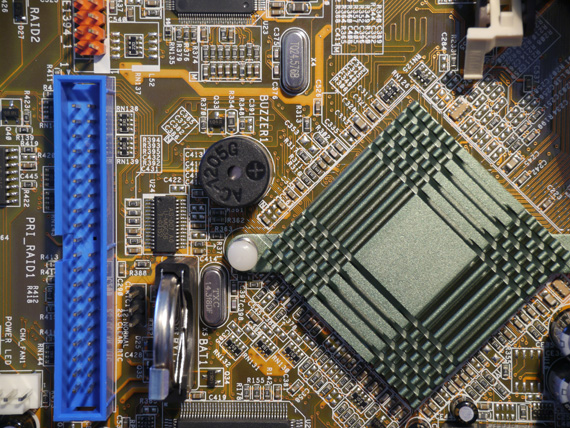Original URL: https://www.theregister.com/2012/05/31/review_panasonic_dmc_gx1_compact_system_camera/
Panasonic DMC-GX1 compact system camera
Micro Four Thirds maestro
Posted in Personal Tech, 31st May 2012 06:00 GMT
Review Panasonic’s DMC-GX1 camera is the Lumix model many Micro Four Thirds enthusiasts have been waiting for since the release of popular DMC-GF1 back in 2009. This 16Mp shooter will appeal to seasoned users with easily accessible controls for customisation on an enticingly compact aluminium body – a combination that will take it places that wouldn’t suit lugging a full-sized SLR. Furthermore, Micro Four Thirds offers one of the largest ranges interchangeable lenses in the compact system cameras category.
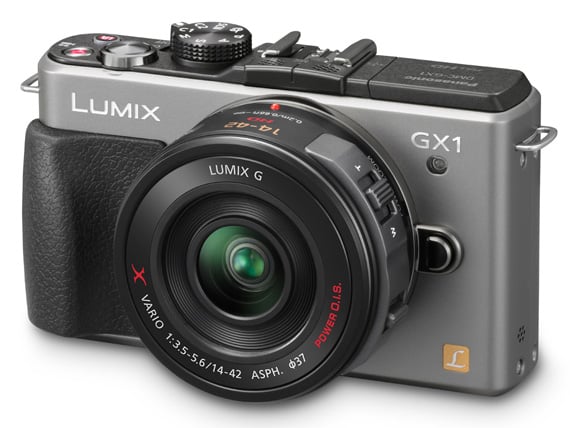
Panasonic’s Lumix DMC-GX1
At the time, given its performance and size, the Panasonic's DMC-GF1 garnered a strong following among enthusiast shooters. I was still toying with the idea of buying a GF1 of my own, when the GF2 was launched. Yet it soon became apparent that the GF2 was not an upgrade to the GF1, but rather it marked a shift towards a more consumer-focused direction for the GF range.
The addition of the DMC-GF2's initially appealing touchscreen interface was at the expense of many of the physical controls that made it so easy to tweak settings on the fly without taking your eye off your subject. Most notably, the mode-selector dial had been removed – deal breaker for me.
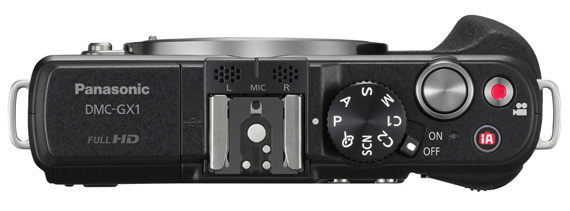
Smile – it has a dial
The GF2 was still a great camera; it just wasn’t the GF1 MkII many of us were after. The GF3 which followed continued in the same direction, being smaller and lighter than either of its predecessors but still lacking the controls of the GF1.
This is where the GX1 comes in. At first glance it looks very similar to the GF1 of old featuring a top-mounted mode dial and an encouraging number of control buttons at the rear. Of course, Panasonic couldn’t take a step backwards from the new GF range, so you get the touchscreen control too, along with a good deal of technological advances which have been achieved since the original GF1 was created.
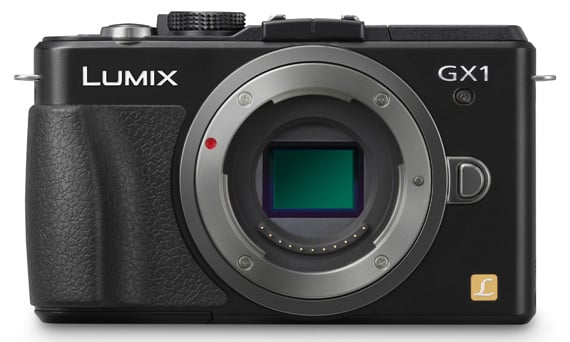
Smaller sensor allows for less bulky lenses
Besides the 16Mp CMOS sensor for stills, video capture at 1080i/60fps or 720p/30fps is on-baord too. The camera is also a whole lot faster, not only in general operation but also in terms of frame capture speeds and autofocus operation. Full resolution images can be captured at up to 3 shots per second, increasing to 4.2 per second with live view disabled. Depending on the attached lens, autofocus feels almost instantaneous.
Icon driven?
Panasonic’s own marketing blurb emphasises ‘iconic design’ and ‘timeless fashion taste’. While the DMC-GX1 is certainly a good-looking camera, for the enthusiast at least, there are other cameras which do a better job in terms of making a fashion statement. For instance, the multiple colours of the Olympus PEN range or the unashamed retro styling of Fujifilm’s recent X-Pro1 and X100 APS-C sensor offerings.
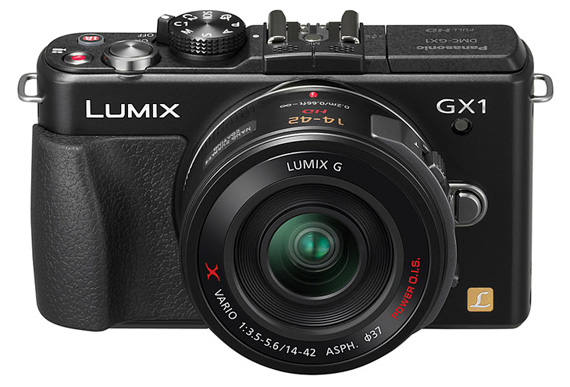
Stylish, but not the fashion statement of its rivals
The Lumix DMC-GX1 on the other hand has been designed with functionality and usability prioritised above mere appearance. Its appeal is lies in the fact that it is great to handle and use, not because it’s trying to ape a Leica rangefinder. The build quality is excellent; feeling reassuringly solid in the hands and trustworthy enough to join you on you more epic adventures – and make it back in one piece.
Being a respectable camera, the GX1 doesn’t invite itself to be touched. There’s plenty on offer from the touchscreen, but it most certainly waits for you to make the first move. With comprehensive physical controls on-hand, it’s easy to forget that there are powerful touchscreen controls available.
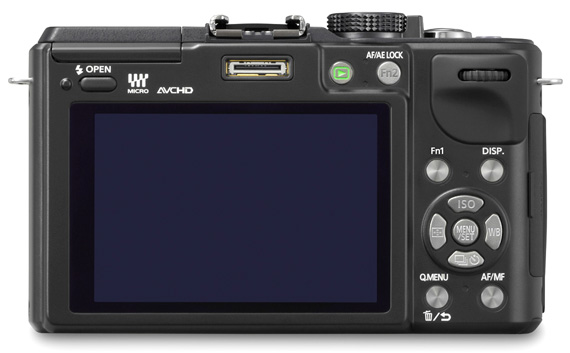
Touchscreen LCD, yet a pity it's not an articulating panel
One obvious advantage of the touchscreen is that, being always illuminated, you can use it easily in the dark, which is just as well because the tiny silver-on-silver legends of the control buttons are difficult enough to read in even broad daylight.
I found the touch focus options the most useful, especially when working with a shallow depth of field where you can simply tap on the area of the picture you want to be in focus. This works in video mode too. It’s also handy when using manual focus as you can drag a magnified portion of the image around the screen to make fine adjustments.
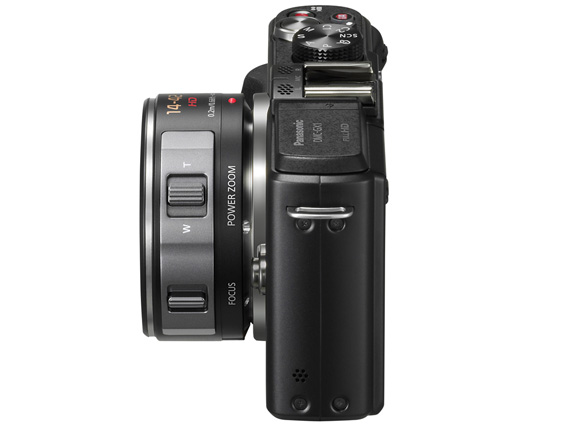
The Lumix G X 14-42mm kit lens is described as a pancake zoom
A wealth of display options allow you to keep the screen as simple as a basic viewfinder, or something so complex, you could mistake it for a full-on flight simulator complete with missile targeting system and a virtual horizon in the form of the new levelling gauge.
Sample Shots
Lumix G X 14-42mm pancake zoom (35mm equivalent: 28-84mm)

Wide-angle: lens swapping has its hazards, dirt on the sensor shows in the sky
Click for a full-resolution crop
ISO Tests
Artificial intelligence
I wouldn’t expect an enthusiast camera such as the GX1 to bother you with patronising levels of help and guidance. You know what aperture and shutter speed do, so you don’t want pretty pictures to show you how to use them. However, when it comes to some of Panasonic’s own features, that may be less familiar, the total lack of on-camera guidance can be somewhat frustrating.
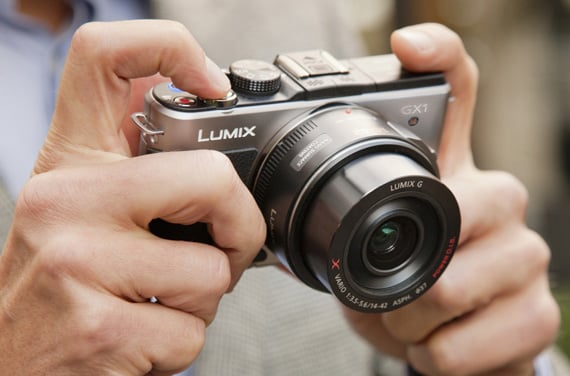
Handles nicely and performs swiftly
Even the fully-automatic ‘Intelligent Auto’ mode has an ‘Intelligent Auto+’ option, but what does this do? Does it make the camera even more intelligent? If so, why would you ever use the less intelligent version? The answers to this kind of question lie in the PDF manual on one of the accompanying CDs, but no doubt enthusiasts will have pored their way through every detail before venturing forth.
And if you're curious, Intelligent Auto+ option adds a little more manual control to the standard version, allowing you to tweak the colour balance and brightness of your image, while leaving the camera to get on with making all the other more complex decisions.
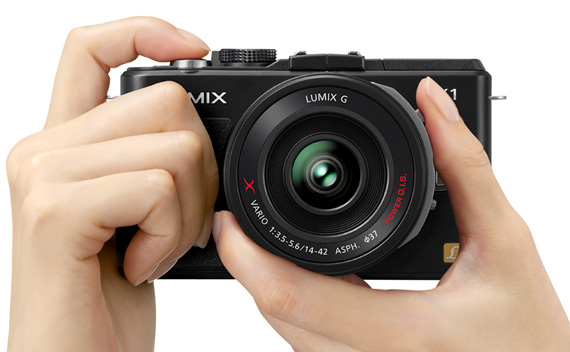
Intelligent Auto or Intelligent Auto+ – which is the cleverer?
As with previous Panasonic models, Intelligent Auto mode is accessed from a dedicated button which lights up bright blue to alert the world to the fact that you don’t know how to work your camera. Or, perhaps you’re simply using it to grab a quick opportunistic shot before returning quickly to your customised settings at the touch of a button.
Of course, there’s also full manual control along with the usual shutter and aperture priority modes. Seventeen scene modes are included, along with eight expressive effects modes. You also get immediate access to important functions such as exposure compensation and a moveable live histogram. Two custom modes are included for you to save your favourite settings.
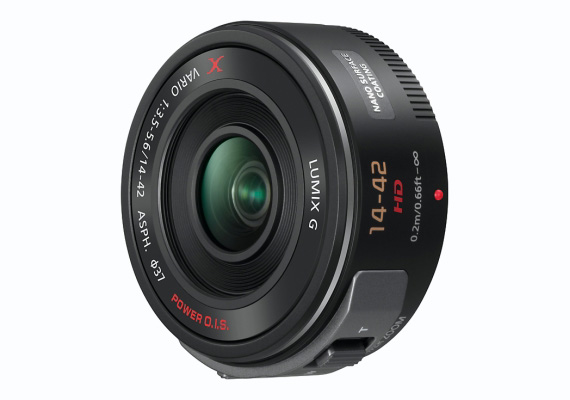
Kit lens: Lumix G X Vario PZ 14-42mm/F3.5-5.6 ASPH/Power O.I.S
The review model came fitted with Panasonic’s new Lumix G X 14-42mm motorised zoom lens. Described by the vendor as a ‘pancake zoom’ it collapses down to a size almost as small as Panasonic’s 20mm f1.7 prime. While included in the kit price, bought separately the new lens does come at a considerable premium over the larger standard zoom lens, setting you back around £370.
Even so, the new 14-42mm pancake zoom lens is a great match for the GX1, delivering a very useful zoom range in a surprisingly small size. The motorised zoom is handy, but the motorised manual focus button is somewhat slower and less accurate than simply grabbing and twisting a focusing ring directly. It has a minimum focusing distance of 20cm which is considerably closer than the 30cm of the cheaper standard version, but these desirable, yet relatively minor, advantages come at a cost that many will find hard to justify.
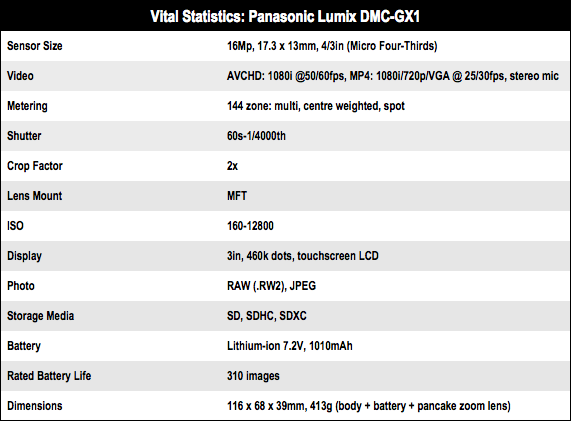
Pancake recipe
With the tiny new zoom fitted, the GX1 slips easily into a coat pocket and becomes a very flexible take-anywhere camera. APS-C based cameras, such as Sony’s NEX range may offer much smaller camera bodies, but the lenses are necessarily much larger, making them more bulky when fitted with a zoom. The GX1’s larger body, but more compact overall kit size makes for much better handling.
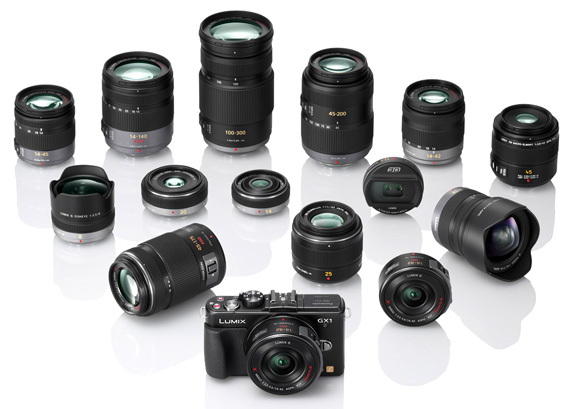
A full family of lenses and compatible with other MFT makers
The GX1 delivers significant refinements over the GF1, with its ISO sensitivity now extending as high as 12800. It also does a pretty good job even at this high sensitivity and is a vast improvement upon the previous generation Micro FourThirds cameras. Despite its relatively small sensor – when compared to DSLRs and APS-C compacts – the results were impressive. Exposure was handled well both indoors and outdoors, and the auto white-balance did a good job of rendering colours faithfully under a variety of lighting conditions.
Even with tricky exposures, the GX1 rarely put a foot wrong. Difficult scenes such as backlit naked branches backlit or the subtle shades of clouds against a grey sky were most often rendered without any loss of detail due to overexposure provided the ISO setting was kept low enough.
There’s plenty of competition for the LumiX DMC-GX1 from other vendors, but perhaps the biggest threat comes from Panasonic’s own Lumix DMC-G3. It’s physically a little larger, but features an almost identical image sensor and broadly similar features minus a few physical controls. Lest we forget, Panasonic has recently unveiled the DMC-GF5 – a revamped DMC-GF3 with full HD video capture.
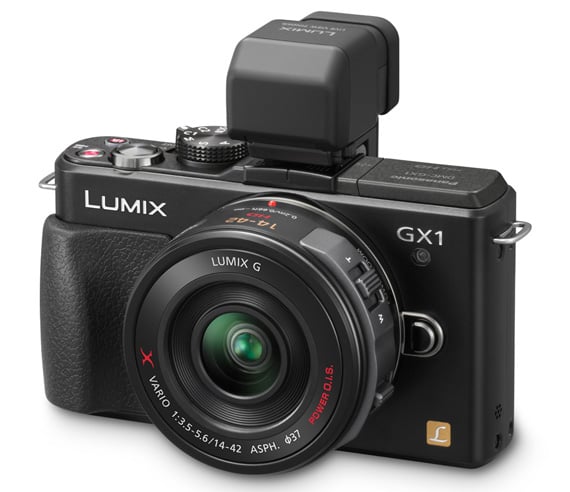
The DMW-LVF2 electronic viewfinder is a useful but costly extra
The DMC-G3 also costs less yet comes with a fully articulating screen, and that expensive electronic viewfinder is already built in. If you don’t need the articulated screen, the GX1 is clearly a better camera but the DMC-G3 is much better value for money. Indeed, this is no cheap alternative to a DSLR, this is a serious camera which costs serious money if you kit it out with the best lenses and accessories – indeed these pricey extras do impact on the overall rating here. For instance, the optional DMW-LVF2 electronic viewfinder will add around £230 to the cost of the camera. And if the EVF and compactness is important to you, then there's always the Nikon One V1 for about the same price as the DMC-GX1 without the DMW-LVF2.
Verdict
If you loved the GF1, the GX1 could be exactly the camera you’ve been waiting for. Its superb build quality and ergonomics are matched with speedy performance and excellent image quality. It’s a little unnecessarily complicated to use and could do with a few more operational hints from the screen, but put in a little time with the manual and you’ll reap great rewards. Save a few quid and buy the lens kit with the new Lumix X 14-42mm zoom and you have a very flexible, pocketable camera with superb control and performance. ®
More Compact System Camera Reviews… |
||||
 Sony Sony
NEX-7 |
 Pentax Pentax
Q |
 Olympus Olympus
PEN Mini E-PM1 |
 Samsung Samsung
NX200 |
 Nikon Nikon
1 V1 |













